Recently, I was lucky enough to perform the music of Hayao Miyazaki’s Studio Ghibli films with composer Joe Hisaishi at the baton. One thing, though: I’d never watched any of the movies. I’d heard of Miyazaki, of course, and had peripheral awareness of the films by their cultural impact (Totoro art in artist alleys, No Face cosplayers at conventions, etc.). Just for various reasons, I missed the Miyazaki train.
So this month, I decided to rectify this situation and watched all 10 of Miyazaki’s Studio Ghibli films within the span of about 2 weeks. And of course, I then had to rank them. Since I didn’t grow up with them, there was no nostalgia element, and since I’ve been spoiled by seeing the visuals of the films in various places across the years, there’s no novelty aspect either. Also, as a writer, I’m biased toward storytelling over pure visuals.
Of course, every single one of these movies is brilliant, so basically this is a list that goes from brilliant to brilliant-est. And now, without further ado, the un-nostalgic ranking:
10. Porco Rosso (1992)
This is a weird little movie about an Italian World War I ex-fighter pilot who, disillusioned by war, cursed himself to be an anthropomorphic pig and now works as a bounty hunter, chasing down air pirates. The anti-war message rings through loud and clear, and the film is a love letter to early aviation, with sweeping visuals of early 20th century planes rendered in gorgeous colors. Porco Rosso, which means “Red Pig” in Italian, is cynical about humanity, even pushing away longtime friend and love interest Gina. Yet despite its heavy subject matter, most of the movie has a light tone, with the cartoony air pirates being more comic relief than villainous or dangerous.
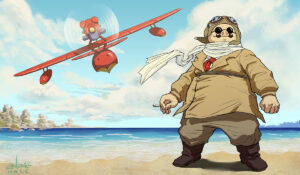
There’s not a bad movie in Miyazaki’s portfolio, and Porco Rosso is for sure an interesting character portrait with gorgeous, understated music and compelling animation. But this list had to start somewhere, and the juxtaposition of the heavy war themes and the cartoony villains, plus the lowest stakes of all the films, meant it just wasn’t my favorite.
9. Castle in the Sky (1986)
In a fantastical version of 19th century Europe, full of steampunk and dieselpunk technology, the orphan girl Sheeta falls from an airship following a pirate attack but floats to the ground thanks to the magic in her mysterious crystal pendant. She’s soon discovered by Pazu, also an orphan, whose late father claimed to have seen Laputa, the titular castle in the sky, a lost civilization of immense power believed to still be floating among the clouds. Sheeta and Pazu race across the land to keep the crystal away from the army and find Laputa.
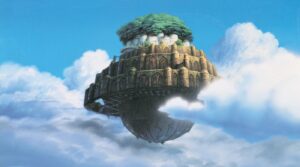
Full of stunning depictions of imaginative machines, which somehow feel fantastical and down-to-earth at once, Castle in the Sky sets a high bar for future steampunk and dieselpunk artists. It’s a fun story for sure, and a visual feast. The reason it didn’t rank higher, for me, was because it was more style than substance, especially compared to some of Miyazaki’s stronger scripts, and because the character of Sheeta was depicted as a passive pretty girl who does little more than cling to Pazu until the very end.
8. Ponyo (2008)
In this adorable take on the Little Mermaid template, a goldfish is rescued by a five-year-old boy, Sōsuke, who names her Ponyo, and a friendship blossoms. So when Ponyo’s father, a sea-dwelling wizard, “rescues” her and takes her back to the sea, Ponyo acquires and unleashes magic to turn human and return to Sosuke, with unexpected consequences.
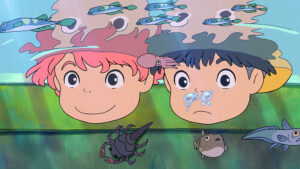
For a movie aimed at kindergarteners, Ponyo includes a lot of themes around parent / child relationships and, of course, Miyazaki’s signature environmentalism. I did love that unlike the Little Mermaid, Ponyo makes no deals and defies her father to cast the spell on herself, making it clearer that becoming human is an assertion of her independence rather than purely over a boy. The depictions of sea magic include some truly innovative artwork, and Hisaishi’s vivacious score, alternating between epic and whimsical, help bring this charming children’s tale to life.
7. Howl’s Moving Castle (2004)
Put down your pitchforks, I said all of Miyazaki’s films were brilliant, didn’t I? In this fan-favorite film, 18-year-old Sophie is cursed to look like a 90-year-old woman after a chance encounter with the charming but shallow wizard Howl, owner of the titular moving castle. The villain behind this curse is the Witch of the Waste, who once had a fling with Howl while in the guise of a beautiful woman (because, of course, witches are hideous) and still isn’t over his rejection. Sophie ventures away from home in search of a counter-curse and stumbles upon Howl’s castle and makes herself at home, declaring herself the new cleaning lady. Howl, meanwhile, spends his days turning into a giant black bird creature and disrupting both sides of a war that the king wants him to fight in and enlists Sophie’s help in resisting those orders. Also, he has no heart. And there’s a fire demon bound to the castle who says he’ll remove Sophie’s curse if she’ll remove his.
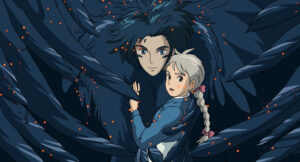
Confused? Me too. And it gets more confusing after that, but I won’t get into it because a) spoilers and b) this entry is getting too long already. Howl’s Moving Castle is the result of two very different creative minds: the novelist Diana Wynne Jones, who wrote the book on which the film was based and, as far as I can tell, was composing a whimsical fantasy adventure, and Miyazaki, who as a lifelong pacifist was firmly opposed to the Iraq War and wanted to make a statement with this film (hence Howl refusing to fight and the unclear reason behind the war). And, for me at least, it felt like two films smashed into one that sacrificed details along the way.
Again, put down your pitchforks! I’m not saying the movie was bad! It’s easy to see why this enchanted world is the source of so many obsessions. The castle itself is pure genius, resembling some kind of sea creature made of steampunk buildings. Howl is your classic neo-Byronic charmer—smooth-talking, vain, rakish, yet with an undeniable goodness about him. A YA boy if there ever was one. And Sophie, is a compelling lead character, sympathetic and upright without veering into sanctimonious territory. I also loved the way her aging is depicted—not as a universally terrible thing, but in fact the impetus for her to gain confidence. Plus, Hisaishi’s score in this one is absolutely iconic.
It’s easy to see why this movie is so many people’s favorites. Perhaps if I’d encountered it as a kid or a teen, rather than a nitpicky adult, I would’ve glossed over the confusing plot and put this closer to the top.
6. Nausicaä of the Valley of the Wind (1984)
Perhaps the most on-the-nose film depicting Miyazaki’s environmentalism and pacifism, Nausicaä of the Valley of the Wind takes place in a post-apocalyptic world that remains after toxic waste devoured most of the planet. Nausicaä, the glider-riding teenaged princess of the Valley of the Wind, becomes embroiled in a conflict with two other kingdoms that threatens to destroy them all. Also, there are giant mutant insects that live in a toxic swamp, which the others see as a threat that needs to be eliminated, but Nausicaä understands that they’re vital to the balance of the world and strives to stop their destruction.
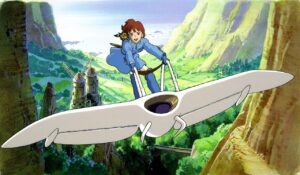
Though it’s about as subtle as a sledgehammer in terms of its messages, the Nausicaä is a captivating film full of innovative worldbuilding and intriguing plot twists. Not to mention heart-pounding and visually stunning action sequences. The story contains a lot of interesting details and histories about the future it takes place in and, in my opinion, is one of the most original pieces of sci-fi out there.
5. My Neighbor Totoro (1988)
The HBO Max description of My Neighbor Totoro warned me that it was deceptively simple, and it took some mulling after the fact to understand how amazing it truly is. The character Totoro is, of course, iconic, being the Studio Ghibli icon and the inspiration for countless fan art and merchandise. So I was surprised by how little he’s actually in the film, which is about two young girls doing their best to adjust to a new home with their father while their mother is in the hospital. As they explore the house and surrounding woods, they encounter fantastical, whimsical spirits.
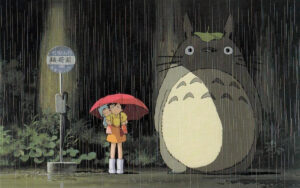
Simple, right? I’ll admit, there isn’t a lot of plot—it’s more of a “slice of life” tale, plus friendly forest spirits. Yet the film is very emotionally complex beneath its cute exterior, dealing with the challenges of childhood against the backdrop of idyllic rural living. It also explores themes of animism and Shinto symbology specific to Japanese culture (and, of course, environmentalism).
4. Kiki’s Delivery Service (1989)
13-year-old Kiki chooses to follow witch tradition and leave home for a year as part of her training. So she hops onto a broom with her talking cat, travels to a lovely seaside town, and sets up a flying delivery service. But things are harder than she’d hoped as she struggles to find work, make friends, and overcome her own insecurities.
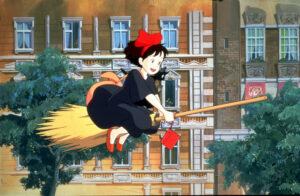
Despite its simple premise, Kiki’s Delivery Service is one of the most emotionally intelligent depictions of adolescence I’ve ever seen. The witch aspect is a gateway to explore Kiki’s inner life as she deals with the struggles of growing up. There’s plenty of fun to be had, of course, including an escapade where the cat tries to cover for Kiki’s botched delivery. Needless to say, the film is visually delightful, with an equally delightful score.
3. Spirited Away (2001)
10-year-old Chihiro and her parents unknowingly enter a recreational village for spirits, where the parents are promptly turned into pigs by the witch Yubaba. With the help of Yubaba’s apprentice, Haku, Chihiro navigates the spirit world and searches for a way to save her parents. This straightforward plot serves as a vehicle to explore a supernatural carnival of chaos, full of magic and spirits from Japanese Shinto folklore, while also developing Chihiro’s character as she gains confidence and independence along her journey.
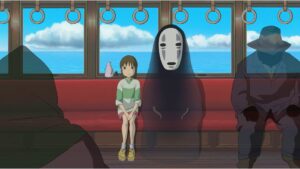
A lot of people put Spirited Away at the top of their Miyazaki lists, and I can see why. Needless to say, it’s stunning. Imaginative visuals, colorful characters, fascinating mythology… no wonder it gets praised to the high heavens. The reason it isn’t in the number one, or even number two, spot is because, for me, both the plot and the character were too predictable and straightforward compared to those in the films that topped it.
2. The Wind Rises (2013)
“Really? This one?” I haven’t even written my blurb yet and I can already hear the scoffing. Hear me out. The Wind Rises was intended to be Miyazaki’s swan song, the last film before he retired (he has since un-retired and is working on what’s meant to be his last-last film). It’s the fictionalized story of Jiro Horikoshi, who designed the warplane used by Japan during World War II, but swaps his personal life for one based on the semi-autobiographical novel The Wind Has Risen by Tatsuo Hori. Basically, Jiro loves aviation but can’t become a pilot due to his nearsightedness and becomes an airplane designer instead. Along the way he meets and falls in love with Nahoko, who has tuberculosis.
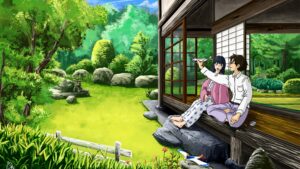
Once again, Miyazaki is being deceptively simple. On the surface, The Wind Rises is a straightforward tale about a dreamer who builds his dream: a beautiful airplane that soars gracefully across the sky. Yet that airplane will be the cause of immeasurable suffering during the war—and Jiro knows it. Though he shows some discomfort with the fact that his invention will be used for war, he never pauses in his design process. He’s too obsessed… he knows his creation is doomed, yet he creates it anyway. Just like he knows his relationship with Nahoko is doomed, yet he marries her anyway.
Jiro is depicted with an air of sweet innocence—cluelessness, even. Yet he’s also the source of much suffering. His obsession with his dream leads him to create a war machine… while neglecting his dying wife, even after being called out by his sister for his cruelty. The Wind Rises is a fascinatingly intricate character study beneath the surface—a portrait of a man who is neither good nor bad, just achingly human. And perhaps familiar to those with geniuses in their lives.
And P.S., it is, of course, gorgeous. If Porco Rosso was a love letter to aviation, The Wind Rises is a whole book of sonnets. Beautiful, graceful airplanes, with a touch of tragedy knowing their eventual fate, soar across the screen. Images of pre-war Japan bring to life an era where the old and the new, the traditional and the modern, live side-by-side in a world before Western-style consumerism has, well, consumed much of it. Hisaishi’s score is very subtle in this one, which makes it all the more powerful (I want to cry just thinking of that last shot of downed warplanes juxtaposed with the dreamy theme… oh, spoiler alert, warplanes get shot down during World War II).
1. Princess Mononoke (1997)
Not gonna lie, I wrestled with making The Wind Rises number one, questioning whether I was the one falling for style over substance this time, but ultimately decided the complexity of the plot and world in Princess Mononoke would merit it taking the top spot even if it weren’t hyperbolically, impossibly, ridiculously gorgeous to look at. A historical fantasy set in the late Muromachi period of Japan (approximately 1336 to 1573 CE), the film follows the noble young prince Ashitaka as he seeks a cure for a curse inflicted upon him during a battle with a demon god. His journey takes him into the heart of a conflict between the ferocious San, nicknamed Princess Mononoke (which refers to Japanese supernatural beings), a girl raised by wolves (literally) in the enchanted forest and sees herself as its guardian warrior, and the industrialist Lady Eboshi, whose fortress consumes the forest’s resources and threaten the spirits living within. Did I mention that Miyazaki is an environmentalist?
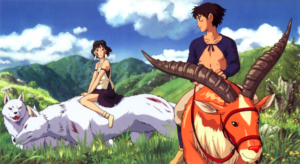
“So Lady Eboshi’s the villain, and our hero must be Team San,” you might think at this point. Except it’s more complicated than that. In fact, San is introduced as a villain, attacking a group of innocent ox herders just doing their jobs because they work for Lady Eboshi, resulting in a few deaths. And Lady Eboshi is introduced as a savior, whose fortress is home to lepers, female ex-slaves (perhaps implied to be sex workers), and other outcasts. While Ashitaka (naturally) falls in love with San and understands her powerful need to guard the forest, he doesn’t forget all the good Lady Eboshi has done for her people. Basically, both sides are right, and both sides are wrong, and fighting won’t solve anything. Did I mention that Miyazaki is a pacifist?
Princess Mononoke presents a captivating tale with no easy answers, full of complex characters, interesting plot turns, and rich worldbuilding. And, in my opinion, it’s also the most visually mesmerizing film of them all, with gorgeous fantasy landscapes populated by spirits from Japanese folklore. Plus some wonderful character design. And amazing action scenes. Hisaishi outdoes himself with the epic score, which is perhaps my favorite as well. Lush and imaginative, complex and fascinating—what’s not to love?
